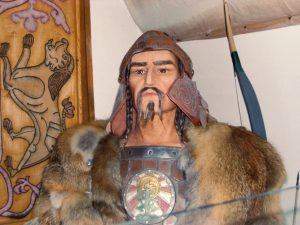Sources vary on the accurate circumstances of Attila’s death, but it was clear he died in 453 AD in present-day Hungary. Most accounts noted that he perished on his wedding night, but the causes of his loss of life differ.
In March 453 AD, he married a young woman named Ildico, his last wife, and there was a feast to celebrate the marriage. The next morning, the guards found the Hun leader in his bed with no wound and his wife weeping over him.
Nosebleed or internal bleeding
When the guards discovered Attila’s passing, they did not find any wound, although he seemed to choke on his blood with a hemorrhage in the nose. In turn, the cause of death in this account was choking from a nosebleed. If not a nosebleed, he experienced internal bleeding due to excessive alcohol intake during the feast, which led to the hemorrhage and his demise.
Wife’s murder and assassination
Marcellinus Comes, a Roman chronicler, wrote about Attila’s passing away 80 years after the incident. The Roman reported that Ildico stabbed the ruler of the Huns. This account coincided with the Volsunga saga and the Poetic Edda with a wife killing the king. However, the incident transpired at the hands of his wife, Ildico.
Meanwhile, some analyses of the event suggest assassination, such as a conspiracy between one of his wives and Roman Emperor Marcian. Still, most scholars reject these accounts, pointing out that the assassination theory is no more than hearsay.
Burial
Some accounts reported that Attila’s men buried him in three coffins, made of iron, silver, and gold, nested inside the other. He was also buried with different spoils of his conquests. According to some legends, those who buried the king were killed to hide the burial site from discovery.
The alleged burial place is in a riverbed that the king’s men diverted into the Tisza River, one of the major rivers in Eastern and Central Europe. To date, no one knows the location of Attila the Hun’s tomb.
Aftermath
Upon discovering that the king had died, his warriors mourned by gashing themselves with their swords and cutting off their hair. The horsemen galloped around the tent of the Hun ruler. Afterward, a celebration called strava with feasting occurred at the burial place of the king of the Huns.
Attila’s death also led to the downfall of the Hun Empire when his sons fought among themselves for control and power. The army became divided to support these sons, namely the appointed successor in Ellak and his brothers, Dengizich and Ernakh. It yielded great losses because of the division of the army, such as in the Battle of Nedao in 454 AD.
